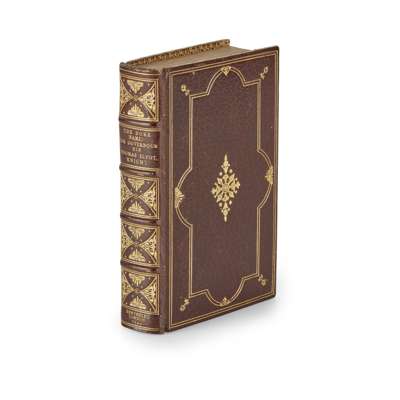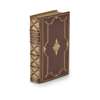
Lot 113

Elyot, Sir Thomas
The boke named the Gouernour deuised by syr Thomas Elyot knyght


Rare Books, Manuscripts, Maps & Photographs
Auction: 23 June 2021 at 11:00 BST
Description
Londini: [in ædibus Thomæ Bertheleti typis impress. Cum priuilegio ad imprimendum solum, An. 1544]. Fourth edition, small 8vo (137 x 81mm), a2-[a8], A1-8 - Z8, a-d8, fine late 19th century or early 20th century panelled calf gilt by Henderson and Bissett, lettered in gilt, g.e., several leaves professionally repaired not affecting text, contemporary pen drawing of a lady's face on a8, next to which in secretarial script is a prayer and the initials M. [D. ?, L. ? or (possibly) A. ?], presumably the owner: "From the horns of unicorns and the roaring of lions, good Lord, save thy poor handmaiden". The reference to unicorns and lions is taken from Psalm 22, v.21. Lady Elyot's (1500-1560/69) maiden name was Margaret à Barrow or Aborough, so one might speculate the initials are M.A.; lacking the title page, later reduced copies of Holbein's portraits of Sir Thomas and Lady Elyot bound in, [ESTC S100426]
Footnote
Provenance: William Graham, JP, FRSAS (1855-1922), Banker, Author of "The One Pound Note", Antiquary & Book Collector; Family books relating to the Andersons and Grahams of Edinburgh
Note: Sir Thomas Elyot's The boke named the Governour appeared in 1531, one year before Machiavelli's The Prince. This copy is the fourth edition, the last to be published during Sir Thomas's lifetime. It is reckoned the first book in Modern English and one of the earliest books exhibiting the spreading influence of the Renaissance and Humanism in England (see Printing and the Mind of Man, p.41, No. 191). Elyot's 19th century editor, Henry Croft, described it as "the earliest treatise on moral philosophy in the English language". It was intended to direct the education of those destined to fill high positions, and to inculcate those moral principles which alone could fit them for the performance of their duties.
Margaret Elyot, née à Barrow or Aborough, was learned in her own right, personally tutored by Sir Thomas More, in whose house she was brought up. It may be speculated therefore that this might have been her copy: given the secretarial hand and her probable knowledge of the Miles Coverdale Bible (1535), the first complete Bible in Modern English, significantly comparable with her husband's "The Governour".
The drawing and inscription is of particular interest. Drawing a "self-portrait" next to an inscription is not uncommon, and the drawing does echo Holbein's portrait of Margaret Elyot. If Margaret did not have her own copy of the Holbein portraits, it is conceivable that she may have drawn her own "copy" here.

